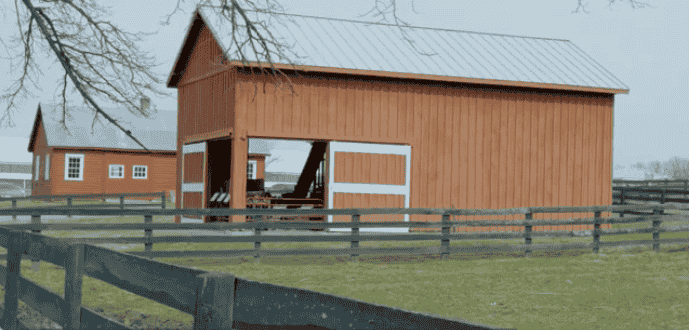You consider various materials for your garden shed and wonder which option offers maximum durability and minimal upkeep. Steel garden sheds excel in strength and longevity, ensuring your investment withstands harsh weather and regular use.
You rely on engineered precision to solve common shed dilemmas. Unlike wooden or plastic alternatives, a steel garden shed provides robust construction and resistance to pests and decay. Their design supports secure storage and functionality.
You can confidently explore options like a steel garden shed to elevate your outdoor space. They seamlessly combine practicality with modern aesthetics, effectively solving your storage and durability challenges without compromise.
Read more: Why Scheduled Lawn Maintenance is Key to a Healthy Lawn
Metal Versus Wood Shed
You face a tough decision when comparing metal and wooden sheds, each bearing unique qualities that affect maintenance, durability, and visual appeal around your garden.
- Durability and Maintenance: Metal sheds offer exceptional longevity and resist weather damage, while wooden sheds demand frequent sealing and insect protection for continued charm.
- Customization Opportunities: Wooden options enable personalized finishes and design details, whereas metal variants provide a modern look with limited modifications over time.
- Weather and Noise: Metal sheds may ring when rain hits, contrasting with the subtle acoustics of wood that naturally blend into your landscape.
- Visual Integration: Wood integrates seamlessly with garden scenery, while metal tends to stand out, appealing to minimalistic and modern aesthetics.
- Long-Term Investment: Choosing metal often means fewer repairs and replacements, though wood lends itself to creative customization for hobbyists and decorators alike.
Your decision should align with your priorities on durability versus aesthetic flexibility, ensuring the shed integrates well with your outdoor living space.
You May Also Like: How to Apply Prodiamine 65 WG for Maximum Lawn Protection
Metal Versus Plastic Shed
Deciding between metal and plastic sheds involves weighing the trade-offs of long-lasting durability, cost efficiency, and design flexibility to secure the best option for your outdoor storage.
Durability and Environmental Resistance
Metal sheds offer fire resistance and superior impact strength, enduring harsh weather and potential vandals much better than plastic, which may warp under relentless UV exposure.
Maintenance and Upkeep
While metal requires minimal cleaning with occasional rust prevention, plastic sheds boast effortless upkeep but may need frequent replacement due to cracking and pest vulnerabilities.
Cost Considerations
Initial expenses tend to be higher for metal sheds; however, their long-term performance and lasting quality justify the investment compared to the lower upfront cost of plastic structures.
Security and Structural Integrity
Metal constructions provide robust security against break-ins and damage, whereas plastic sheds are lighter and may compromise safety in severe weather or impact situations.
Installation and Custom Fit
Sturdy metal builds demand anchoring and careful placement, while plastic versions offer easier assembly and repositioning.
The differences outlined highlight that metal sheds may serve better for longevity and security, favouring those with long-term outdoor storage requirements.
Strength and Durability Factors
Understanding strength and durability is key when selecting your shed, focusing on design, material quality, and construction techniques that ensure lasting outdoor service.
- Weather Resistance: High-quality panels, proper insulation, and UV protection safeguard metal and wood sheds from water intrusion and extreme conditions.
- Impact Resilience: Reinforced joints and thick panels aid in distributing shock from storms, ensuring the structure withstands heavy winds and impact forces.
- Corrosion Prevention: Utilizing galvanized metals and regular treatments prevents rust, a common enemy to outdoor structures over time.
- Foundation and Placement: A solid, well-drained base fosters stability. Proper placement minimizes moisture buildup and helps the shed remain level.
- Load Distribution: Ensuring even weight distribution and using additional reinforcements, such as steel beams or plywood, improves overall durability for heavy storage use.
These factors contribute significantly to the resilience of your shed and enable you to enjoy a secure, long-lasting solution regardless of seasonal changes.
Maintenance Needs Compared
Maintenance is a crucial factor when choosing a shed. Each type imposes different routines that could affect your time and overall satisfaction with the structure.
Plastic Sheds: Low Routine Efforts
Plastic models require basic cleaning with soap and water, resisting rot, rust, and infestation while minimizing the need for constant upkeep over many years.
Metal Sheds: Occasional but Essential Care
Metal sheds provide longevity with the occasional need for rust-resistant treatments, ensuring that the structure remains intact and aesthetically pleasing.
Wooden Sheds: Demanding Regular Attention
These sheds invite creativity through painting and staining, yet require periodic maintenance due to moisture exposure and pest-related challenges, demanding greater commitment.
General Maintenance Best Practices
Regular cleaning, inspection, and proper ventilation are essential steps. Applying protective coatings and trimming adjacent vegetation further extend the shed’s life.
Assess your willingness to commit time to maintenance; sometimes the beauty of wood contrasts sharply with the ease of metal and plastic upkeep.
Shed Appearance Differences
Choosing a shed layout influences the appeal of your garden while providing specific benefits that cater to aesthetic and functional requirements in outdoor design.
- Gable (A-Frame): Offers a stylish sloping roof and ample overhead space. Its design is functional yet might struggle with extreme loads during heavy snowfalls.
- Gambrel (Dutch Barn): Features a steep roof for extra headroom and storage; the design efficiently sheds water but may require stronger bracing to handle severe weather.
- Lean-To: A simple, single-sloped roof that delivers an easy installation process and additional shelter, though ventilation might be compromised within the roof area.
- Victorian: Exudes an upscale charm, elevating your property’s aesthetics with decorative elements, though the cost and installation can be significantly higher.
- Flat Roof: Provides a minimalistic design ideal for modern homes; this style is quick to install but demands careful drainage management to avoid water pooling.
This variety enables you to select a design that complements your environment and meets both visual expectations and functional demands in your backyard.
Customization and Flexibility
The ability to tailor your garden shed to specific needs can transform it into an ideal workspace or storage area that truly reflects your personality and requirements.
Tailored Design and Flexibility
Custom sheds offer various sizes, layouts, and finishes that allow you to maximize available space while ensuring that the shed meets distinct storage or creative needs.
Features and Material Quality
High-quality construction techniques and materials provide excellent structural integrity. The design can incorporate windows, skylights, and insulation for year-round use.
Enhanced Functionality and Aesthetic Appeal
Customization enables you to create a dedicated workspace, hobby area, or “she-shed” that not only adds practicality but also elevates your outdoor aesthetics. For more inspiration, learn from this guide from Lowes.
Your custom options promise a personalized retreat that suits your storage needs while adding value and distinctive character to your lawn.
Choosing the Right Shed
Selecting the right shed entails balancing size, layout, and future expansion plans. Practical considerations help ensure that your choice serves long-term needs efficiently.
Size and Space Planning
Calculate your storage requirements by measuring available outdoor space. A well-considered layout provides room for equipment, gardening tools, and additional items.
Design, Layout and Regulations
Evaluate door sizes, wall configurations, and local zoning laws. An optimal design not only meets practical storage needs but also complies with community guidelines.
Long-Term Value and Expansion Options
Consider potential expansion possibilities to prevent outgrowing the shed. Durable construction and future-proofing ultimately contribute to the structure’s enduring value.
This comprehensive approach ensures that you select a shed that adapts to your evolving needs while complementing your garden’s overall aesthetics.
Shed Decisions Simplified
When making your decision, you prioritize quality and longevity in every aspect. You recognize various benefits and challenges with different materials. You know that careful research leads to a well-informed choice. Ultimately, you choose a robust shed tailored to your unique style and practical needs, ensuring lasting satisfaction and value.

